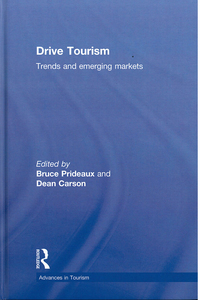Drive tourism: a view from the road
Carson, Dean, and Schmallegger, Doris (2011) Drive tourism: a view from the road. In: Prideaux, Bruce, and Carson, Dean, (eds.) Drive Tourism: trends and emerging markets. Advances in Tourism . Routledge, Milton Park, UK, pp. 358-368.
![[img]](https://researchonline.jcu.edu.au/16478/1.hassmallThumbnailVersion/book_cover-Drive_Tourism.jpg)
|
Image (JPEG) (Book Cover)
- Cover Image
Download (1MB) |
|
|
PDF (Published Version)
- Published Version
Restricted to Repository staff only |
Abstract
[Extract] The nature of self-drive tourism is changing globally. In countries where privately owned vehicles have long been a popular choice of tourism transport, increased access to low-cost airfares and increased costs of vehicle maintenance and fuel have been critical influences. Holyoak et al. (2009) documented the shift in Australia, for example, from a market dominated by tourists 'in transit' - using the vehicle simply as the most convenient mode of transport between the origin and the destination - to one where the use of the vehicle was more central to the enjoyment of the trip as a whole. Consequently, self-drive tourism research is now beginning to pay more attention to four-wheel-drive travel (Taylor and Carson, this volume, Chapter 17; Prideaux and Coghlan, this volume, Chapter 18), caravanning (van Heerden, this volume, Chapter 6; McClymont et al., this volume, Chapter 16), motorcycling (Walker, this volume, Chapter 12) and other subsets of the market where the vehicle itself is embraced as a core attribute of the tourism experience, rather than as a necessary evil of transport. In countries where vehicle ownership is only now becoming widespread (Yu et aI., this volume, Chapter 8; du Cros and Ong, this volume, Chapter 9, which highlight the case of China), whole new types of tourism experiences are being made possible, free from the constraints of scheduled mass transit. The use of the vehicle as conspicuous consumption reflects the rise of new middle classes who want to purchase tourism as part of a confirmation of their new place in a wider world than they previously accessed. It must also be noted that in a number of markets, including China, India, Eastern Europe and South America, self-drive tourism has emerged after the development of low-cost air travel. The development of the self-drive market in these countries will not take the same path as in North America, Europe and Australasia, where the mass ownership of cars pre-dated access to low-cost air travel. Our thesis is that the major change in the global self-drive markets is a shift away from the car as a form of least-cost transport towards the use of a variety of self-driven vehicles that add value to the tourism experience. This book has documented the meaning of that fundamental change in the marketplace from the perspective of the tourist. Chapters have documented what it now means to be a drive tourist in China, a four-wheel-driver in Australia, a motorcyclist in the UK, a motorhome driver in the US, an international self-driver in Brazil, and so on. There have also been reflections on what the global markets and emerging trends mean for the tourism industry - rental car companies in New Zealand, motoring associations, marketers of touring routes and other drive destinations, or emergency services agencies. In this chapter, we use the 'Grand Tour' (Olsen 2002) of Central and Eastern Australia to illustrate the challenges facing destinations and businesses in adjusting to new market dynamics and to synthesise issues raised throughout the book.
| Item ID: | 16478 |
|---|---|
| Item Type: | Book Chapter (Research - B1) |
| ISBN: | 978-0-415-49149-5 |
| Date Deposited: | 23 Jun 2011 02:52 |
| FoR Codes: | 14 ECONOMICS > 1402 Applied Economics > 140216 Tourism Economics @ 100% |
| SEO Codes: | 90 COMMERCIAL SERVICES AND TOURISM > 9003 Tourism > 900301 Economic Issues in Tourism @ 100% |
| Downloads: |
Total: 474 Last 12 Months: 4 |
| More Statistics |



